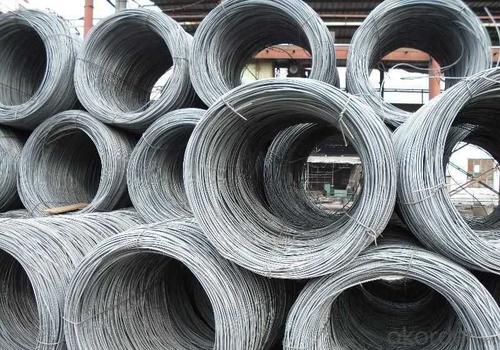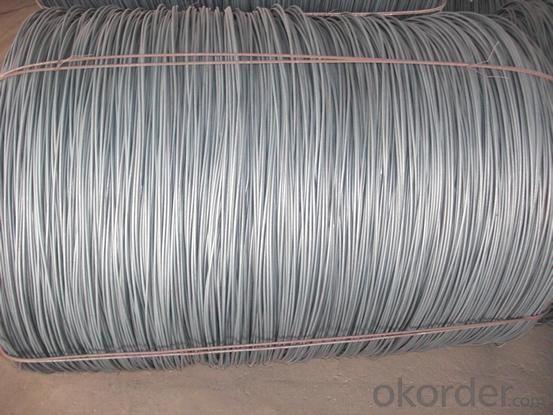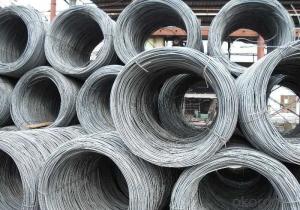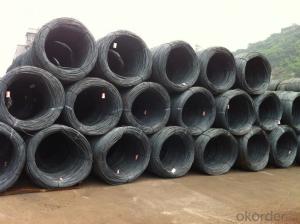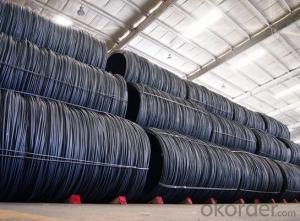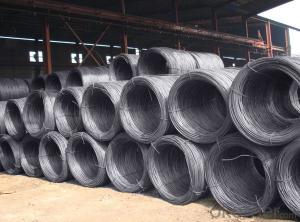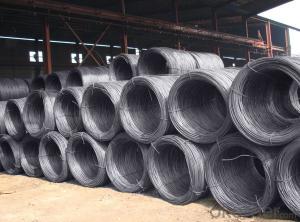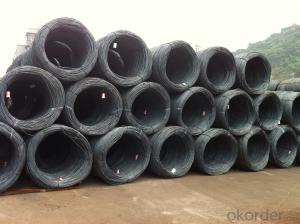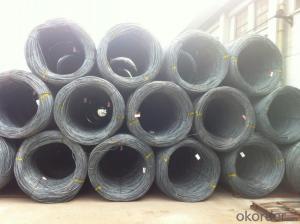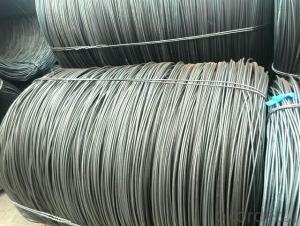Wire Rod Hot Rolled High Quality SAE1008 and SAE1006
- Loading Port:
- Tianjin
- Payment Terms:
- TT OR LC
- Min Order Qty:
- 25 m.t.
- Supply Capability:
- 200000 m.t./month
OKorder Service Pledge
OKorder Financial Service
You Might Also Like
Product Description:
OKorder is offering high quality Hot Rolled Steel I-Beams at great prices with worldwide shipping. Our supplier is a world-class manufacturer of steel, with our products utilized the world over. OKorder annually supplies products to European, North American and Asian markets. We provide quotations within 24 hours of receiving an inquiry and guarantee competitive prices.
Product Applications:
After hot-rolled the products shaped into coil and delivery as finished product, including round, square, rectangular, hexagonal and so on. Since most of the products are round, it is generally called wire rod. Carbon steel wire rod is widely used in construction and manufacturing. Carbon steel wire rod is mainly used for reinforcement of reinforced concrete and welded structure or reprocessed (roberts , nail, etc.) materials, especially used to produce wire drawing, welding electrode, nails, spring, electronic, precise machinery parts and so on.
Product Advantages:
OKorder's Wire Rod Hot Rolled High Quality SAE1008 and SAE1006 are durable, strong, and resist corrosion.
Main Product Features:
· Premium quality
· Prompt delivery & seaworthy packing (30 days after receiving deposit)
· Corrosion resistance
· Can be recycled and reused
· Mill test certification
· Professional Service
· Competitive pricing
Product Specifications:
Manufacture: Hot rolled
Grade: SAE1008 SAE 1006
Certificates: ISO, SGS, BV, CIQ
Diameter: 5.5mm, 6.5mm, 7mm,8mm,9mm,10mm,12mm,14mm, as per customer request
Packaging: Export packing, nude packing, bundled
Grade | Chemical Composition (%) | |||||
C | Mn | S | P | Si | B | |
SAE1008B | 0.10max | 0.32max | 0.045max | 0.040max | 0.30max | 0.0008min |
Mechanical properties | ||||||
Yield strength(N/mm2) | Tensile strength(N/mm2) | Elongation (%) | ||||
≥195 | 350-380 | ≥32 | ||||
FAQ:
Q1: Why buy Materials & Equipment from OKorder.com?
A1: All products offered byOKorder.com are carefully selected from China's most reliable manufacturing enterprises. Through its ISO certifications, OKorder.com adheres to the highest standards and a commitment to supply chain safety and customer satisfaction.
Q2: How do we guarantee the quality of our products?
A2: We have established an advanced quality management system which conducts strict quality tests at every step, from raw materials to the final product. At the same time, we provide extensive follow-up service assurances as required.
Q3: How soon can we receive the product after purchase?
A3: Within three days of placing an order, we will begin production. The specific shipping date is dependent upon international and government factors, but is typically 7 to 10 workdays.
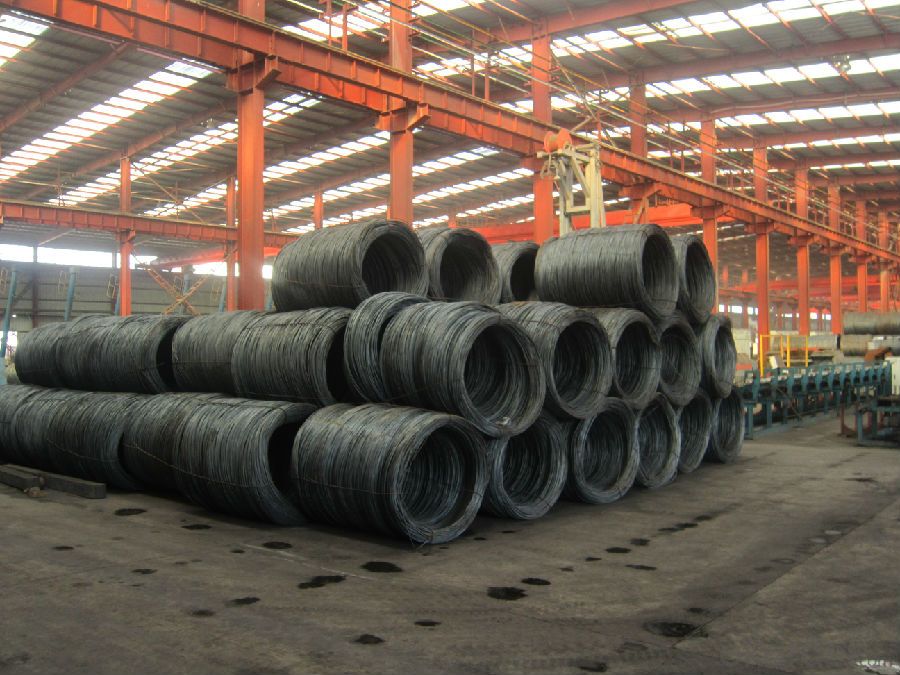
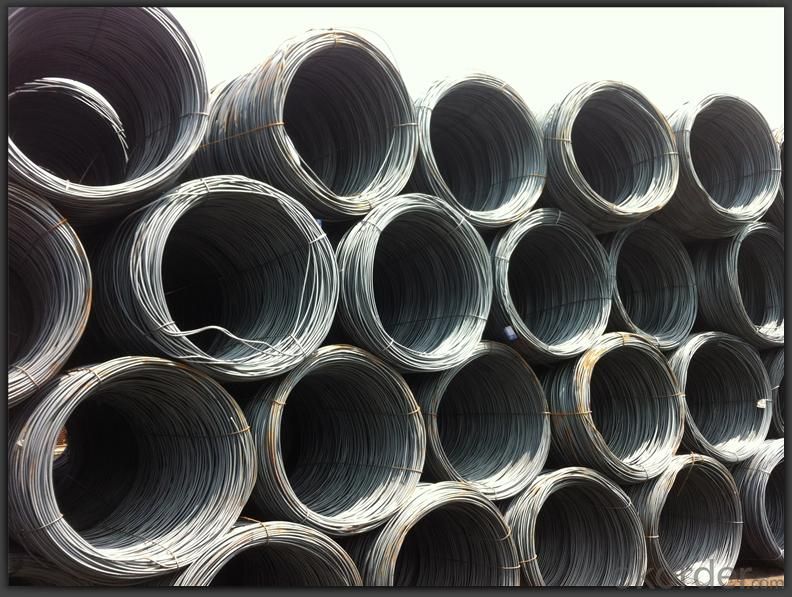
- Q: What are the main factors influencing the choice of steel wire rod distributor?
- The main factors influencing the choice of a steel wire rod distributor include the distributor's reputation and reliability, the quality and consistency of the wire rod they provide, their pricing and availability, their ability to meet specific requirements and specifications, and their customer service and support. Other factors may include their location and proximity to the buyer, their experience and expertise in the industry, and any additional value-added services they offer.
- Q: What are the main regions for steel wire rod production?
- The main regions for steel wire rod production are Asia, Europe, and North America. Asia is the largest producer of steel wire rod, with countries like China, Japan, and India leading the way. China, in particular, holds the largest share of global steel wire rod production, thanks to its vast steel industry and strong domestic demand. Japan is another significant player in Asia, known for its advanced technology and high-quality steel products. India has also emerged as a major producer in recent years, driven by its growing infrastructure and construction sectors. In Europe, countries like Germany, Italy, and France are prominent steel wire rod producers. Germany has a long history of steel manufacturing and is known for its expertise in producing high-quality steel wire rod. Italy is also a significant player, specializing in stainless steel wire rod production. France, on the other hand, benefits from its strategic location and serves as a hub for steel wire rod distribution in Europe. North America is another important region for steel wire rod production, with the United States and Canada as key players. The United States has a well-established steel industry and is known for its advanced production techniques. Canada, although not as large a producer as the United States, still contributes significantly to the North American market. Overall, these regions dominate the steel wire rod production globally, with each having its own strengths and specialties. The demand for steel wire rod continues to grow, driven by various industries such as automotive, construction, and manufacturing, ensuring a strong market for these regions.
- Q: How does the yield strength of steel wire rod vary with different wire drawing processes?
- The yield strength of steel wire rod can vary with different wire drawing processes. Wire drawing is a metalworking process used to reduce the diameter of a wire by pulling it through a series of dies. The yield strength is a measure of the maximum stress that a material can withstand without permanent deformation. One factor that affects the yield strength during wire drawing is the reduction in cross-sectional area. As the wire is pulled through smaller and smaller dies, its diameter decreases, causing an increase in the yield strength. This is because the reduction in cross-sectional area leads to an increased dislocation density within the wire, which impedes the movement of dislocations and makes it harder for the material to deform plastically. Another factor that influences the yield strength is the amount of strain induced during the wire drawing process. Strain refers to the deformation that a material undergoes when subjected to an external force. As the wire is drawn through the dies, it experiences significant strain, which can cause the dislocations to rearrange and form a more organized structure. This can result in an increase in the yield strength of the wire. The temperature at which the wire drawing process is conducted also affects the yield strength. Cold wire drawing, which is performed at room temperature, typically results in a higher yield strength compared to hot wire drawing, which is conducted at elevated temperatures. This is because cold wire drawing induces more strain hardening and promotes the formation of a finer microstructure, leading to an increase in the yield strength. In addition to these factors, the quality and cleanliness of the steel wire rod can also influence its yield strength during wire drawing processes. Impurities and defects within the material can act as stress concentrators and reduce the overall strength of the wire. Therefore, it is important to use high-quality steel wire rod to achieve desired yield strength values. Overall, the yield strength of steel wire rod can vary with different wire drawing processes due to factors such as reduction in cross-sectional area, induced strain, temperature, and material quality. Understanding these factors is crucial in designing and optimizing wire drawing processes to achieve desired mechanical properties for various applications.
- Q: What are the potential applications of stainless steel wire rod?
- The unique properties and versatility of stainless steel wire rod make it suitable for a wide range of applications. Some of these applications include: 1. Construction and infrastructure: Stainless steel wire rod is often used in construction and infrastructure projects due to its strength, durability, and resistance to corrosion. It can be utilized in the production of reinforcement bars, concrete structures, bridges, and other crucial infrastructure components. 2. Automotive industry: Stainless steel wire rod is employed in the manufacturing of different automotive components, such as exhaust systems, suspension springs, and engine parts. Its excellent resistance to heat, corrosion, and high temperatures makes it ideal for demanding automotive applications. 3. Aerospace industry: The lightweight nature and high strength-to-weight ratio of stainless steel wire rod make it suitable for the aerospace industry. It is used in the production of aircraft components, including fasteners, cables, and structural elements, where corrosion resistance and mechanical properties are vital. 4. Medical equipment: Stainless steel wire rod is widely used in the production of medical equipment and instruments due to its biocompatibility, corrosion resistance, and ease of sterilization. Surgical tools, implants, orthodontic wires, and other medical devices are made using stainless steel wire rod. 5. Power generation: The power generation industry utilizes stainless steel wire rod for its excellent resistance to high temperatures, pressure, and corrosion. It is commonly used in the production of turbine blades, heat exchangers, and other critical components in power plants. 6. Food processing industry: Stainless steel wire rod is extensively used in the food processing industry because of its hygienic properties and resistance to corrosion. It is employed in the production of food handling equipment, storage tanks, and processing machinery. 7. Wire products: Various wire products, such as springs, wire mesh, cables, and fencing, are made using stainless steel wire rod. Its high tensile strength, corrosion resistance, and flexibility make it suitable for these applications. 8. Marine industry: The marine industry relies on stainless steel wire rod for its resistance to corrosion in saltwater environments. It is used in the production of marine equipment, boat fittings, rigging, and other components. In conclusion, stainless steel wire rod has vast and diverse potential applications, spanning across industries such as construction, automotive, aerospace, medical, power generation, food processing, wire products, and the marine sector. Its exceptional properties make it a reliable and preferred material for critical applications that require strength, durability, and corrosion resistance.
- Q: What are the common industry skills for steel wire rod distributors?
- Some common industry skills for steel wire rod distributors include knowledge of the steel industry, understanding of market trends and customer demands, strong communication and negotiation skills, ability to analyze data and make informed decisions, proficiency in supply chain management, and excellent customer service skills.
- Q: What are the common traceability requirements for steel wire rod?
- Some common traceability requirements for steel wire rod include the need to track and document the origin of the raw materials used, the manufacturing processes involved, and the final destination or customer for each batch of wire rod produced. Additionally, traceability requirements may also involve keeping records of quality testing and inspection results, as well as maintaining a comprehensive documentation system to ensure transparency and accountability throughout the supply chain.
- Q: What are the corrosion resistance requirements for steel wire rod used in marine wire ropes?
- Steel wire rod used in marine wire ropes must possess high corrosion resistance due to the harsh and corrosive marine environment. This is because wire ropes are frequently exposed to seawater, saltwater, and other corrosive substances. Therefore, the steel wire rod used in their construction must have exceptional resistance to corrosion. The foremost corrosion resistance requirement for steel wire rod in marine wire ropes is its ability to withstand and resist the corrosive effects of saltwater. Saltwater is rich in chloride ions, which are highly aggressive and can cause metals to corrode faster. Consequently, the steel wire rod used in marine wire ropes must have a strong resistance to chloride-induced corrosion. In addition to chloride-induced corrosion, the steel wire rod used in marine wire ropes must also demonstrate resistance to general corrosion caused by various environmental factors like moisture, oxygen, and fluctuations in temperature. To prevent or minimize general corrosion, the wire rod should either have a protective coating or be made from a corrosion-resistant alloy. Moreover, the steel wire rod should also exhibit resistance to pitting corrosion, which is localized corrosion that can occur in the presence of specific contaminants or due to surface imperfections. Pitting corrosion can lead to the formation of small holes or pits on the wire's surface, compromising the strength and integrity of the wire rope. To fulfill these corrosion resistance requirements, marine wire ropes commonly utilize stainless steel wire rod. Stainless steel alloys, such as AISI 316 and AISI 316L, are highly regarded for their exceptional resistance to chloride-induced corrosion, general corrosion, and pitting corrosion. These alloys contain a higher chromium content, which forms a protective oxide layer on the wire's surface, safeguarding it from corrosive attacks. In conclusion, the corrosion resistance requirements for steel wire rod used in marine wire ropes are significant. They necessitate resistance to chloride-induced corrosion, general corrosion, and pitting corrosion. Stainless steel alloys, specifically AISI 316 and AISI 316L, are frequently employed to meet these requirements due to their outstanding corrosion resistance properties.
- Q: How is steel wire rod used in the manufacturing of wire forms for automotive components?
- Automotive components rely heavily on steel wire rod, an essential element in the production of wire forms. These wire forms are intricate designs created from metal wire and serve vital functions in various automotive applications such as springs, clips, brackets, and fasteners. The procedure begins with steel wire rods, typically composed of carbon or alloy steel. These rods act as the raw material for wire drawing, the primary technique employed to manufacture wire forms. Wire drawing involves pulling the steel wire rod through a series of dies to reduce its diameter and increase its length. This process enhances the wire's tensile strength and surface finish, making it suitable for automotive purposes. Once the desired wire diameter is achieved through wire drawing, it is then fed into specialized machinery to form different wire forms. This machinery comprises automated CNC (Computer Numerical Control) machines capable of bending, shaping, and cutting the wire precisely to meet specifications. By utilizing various tools and dies, these machines shape the wire to the desired form, ensuring accuracy and consistency. Wire forms produced from steel wire rod offer several advantages for automotive components. Firstly, steel wire rods possess exceptional strength and durability, enabling them to withstand the demanding conditions found within automotive systems. They can endure high temperatures, vibrations, and mechanical stresses, ensuring the wire forms maintain their structural integrity over time. Moreover, steel wire rods provide flexibility in terms of design and customization. Manufacturers can easily produce wire forms of different sizes, shapes, and configurations to meet the specific requirements of various automotive components. This versatility allows for the creation of wire forms tailored to fit the precise needs of the automotive industry, enhancing the overall performance and functionality of these components. Additionally, steel wire rods are cost-effective and readily available, making them the preferred choice for wire form manufacturing in the automotive sector. The abundance of steel as a raw material ensures a stable supply chain, enabling manufacturers to efficiently meet the high demands of the automotive industry. In conclusion, steel wire rod plays a vital role in manufacturing wire forms for automotive components. Through the processes of wire drawing and specialized machinery, steel wire rods are transformed into intricate shapes and designs that offer strength, durability, and flexibility. This enables the production of wire forms that meet the stringent requirements of automotive applications, ultimately contributing to the overall functionality and performance of automotive components.
- Q: What are the different high-temperature properties of steel wire rod?
- Various applications can benefit from the suitability of steel wire rods due to their multiple high-temperature properties. Among these properties, high thermal stability stands out as a key feature. It enables the wire rods to maintain their structural integrity even when exposed to elevated temperatures. This characteristic is crucial in industries like automotive and aerospace, where parts made of steel wire rods endure high temperatures during operation. Another significant property of steel wire rods at high temperatures is their resistance to oxidation. To protect against corrosion, these wire rods are usually coated with a layer of zinc or galvanized coating. This protective layer acts as a barrier, preserving the wire rods' strength and preventing them from corroding when subjected to harsh environments and high temperatures. Furthermore, steel wire rods exhibit exceptional mechanical properties at elevated temperatures. They possess high tensile strength and good resistance to creep, allowing them to endure heavy loads and prolonged exposure to high temperatures without deforming or breaking. These characteristics make them an ideal choice for industries such as construction and manufacturing, where strength and durability are essential. Moreover, steel wire rods also exhibit good thermal conductivity, enabling efficient heat transfer. This property proves beneficial in applications like heating elements, where the wire rods are utilized to generate and distribute heat evenly. In conclusion, the various high-temperature properties of steel wire rods, including thermal stability, resistance to oxidation, excellent mechanical properties, and good thermal conductivity, make them a versatile and dependable material for numerous high-temperature applications across various industries.
- Q: How is steel wire rod used in the manufacturing of wire rope grilles?
- Steel wire rod is used in the manufacturing of wire rope grilles as it serves as the raw material for creating the individual wire strands that make up the rope. The steel wire rod undergoes various processes such as drawing, stranding, and coating to form the strong and durable wire strands, which are then twisted together to create the wire rope grille.
Send your message to us
Wire Rod Hot Rolled High Quality SAE1008 and SAE1006
- Loading Port:
- Tianjin
- Payment Terms:
- TT OR LC
- Min Order Qty:
- 25 m.t.
- Supply Capability:
- 200000 m.t./month
OKorder Service Pledge
OKorder Financial Service
Similar products
Hot products
Hot Searches
Related keywords



